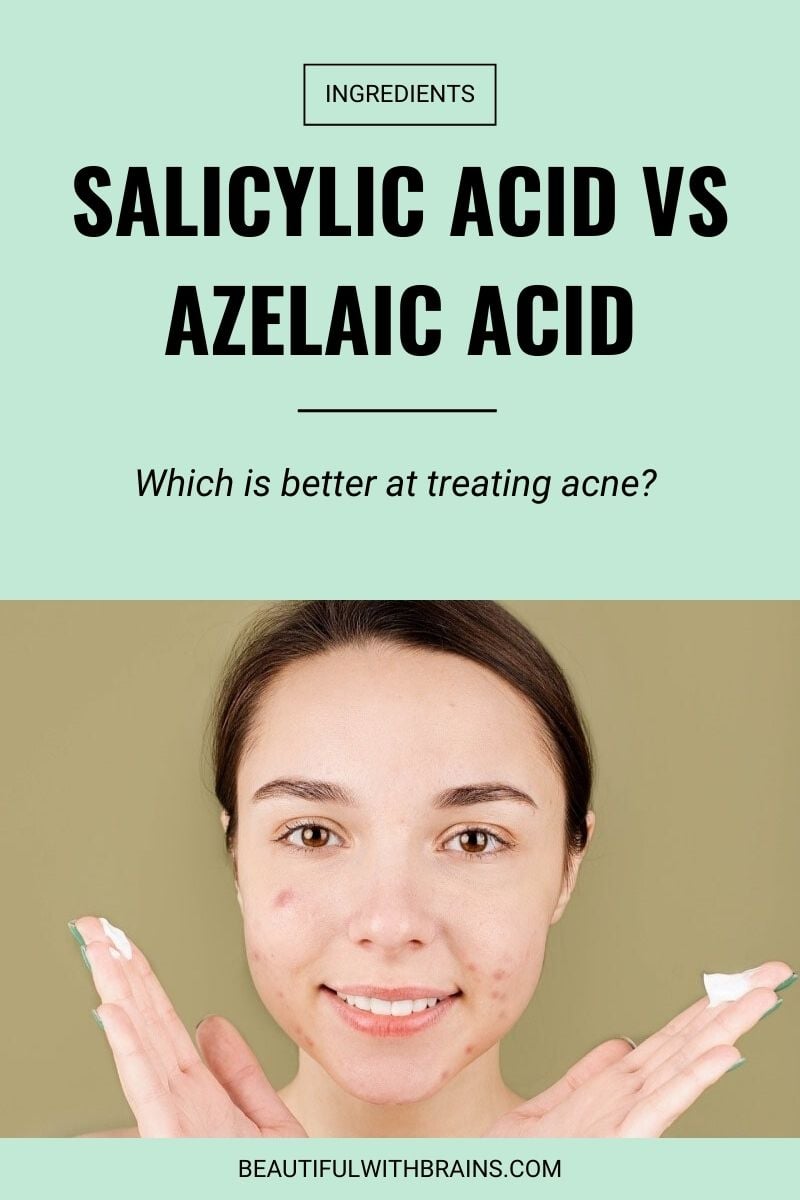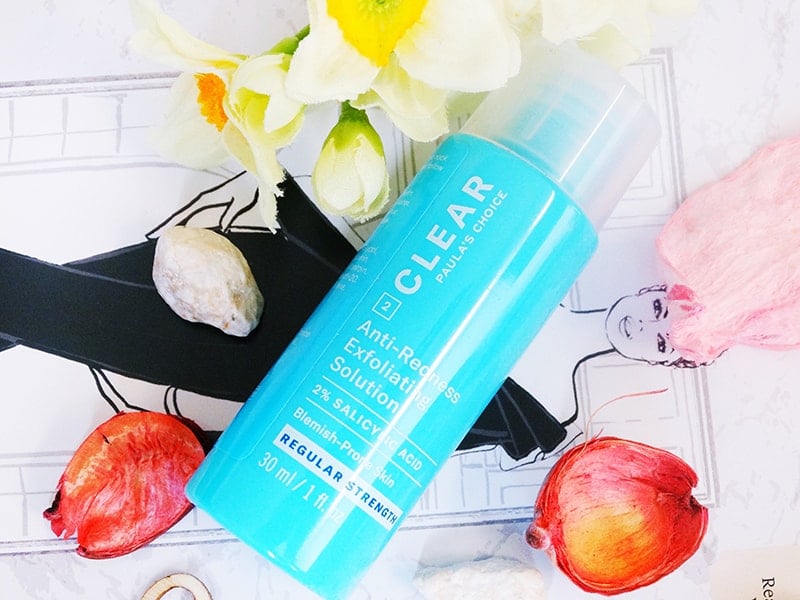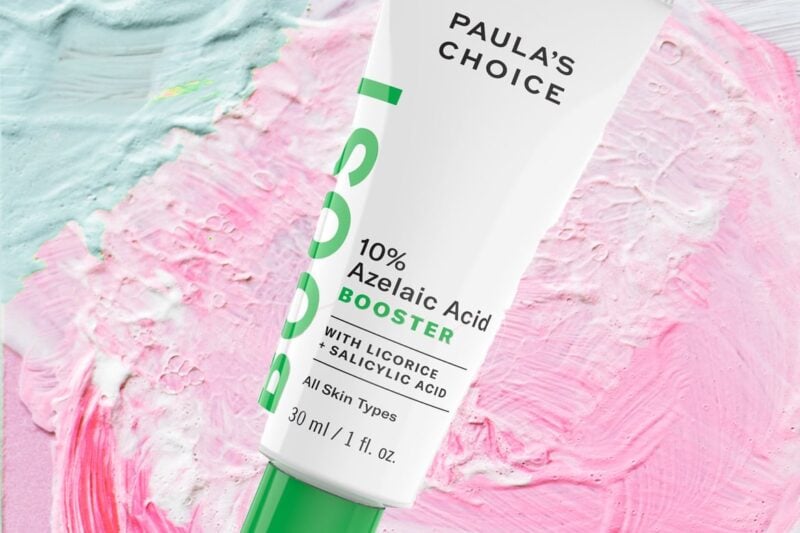
Azelaic Acid VS Salicylic Acid: if you’re face is riddled with pimples, you’re probably wondering which one is best at treating acne.
Salicylic Acid has always been my go-to for all kinds of acne. Blackheads. Whiteheads. Pimples. You name it. It gets rid of them all.
But now there’s a new kid on the skincare block. Azelaic Acid is said to treat acne just as well – and fade away your dark spots too. Should you make the switch?
Mmm…. Here’s all you need to know about Azelaic Acid vs Salicylic Acid and how to tell which one is right for YOU:
- Azelaic Acid: What Is It And What Does It Do?
- Salicylic Acid: What Is It And What Does It Do?
- Azelaic Acid VS Salicylic Acid: What’s The Difference?
- Azelaic Acid VS Salicylic Acid: Do They Cause Acne?
- Azelaic Acid VS Salicylic Acid: Which One Is Better At Treating Acne?
- Who Should Use Salicylic Acid?
- Who Should Use Azelaic Acid?
- Can You Use Azelaic Acid and Salicylic Acid Together?
- How To Use Azelaic Acid and Salicylic Acid Together
- The Bottom Line
MEET THE EXPERTS
- Dr. Yoram Harth, Board Certified Dermatologist, Medical Director of MDacne, and a member of the American Academy of Dermatology (AAD
- Nidah Barber-Raymond/Esthetician, Founder of The Peel Connection
Azelaic Acid: What Is It And What Does It Do?
Azelaic Acid is made by the healthy bacteria that live on your skin. “Azelaic acid is a dicarboxylic acid that is produced in nature by a yeast, Malassezia furfur,” explains board-certified dermatologist and medical director of MDacneDr Harth. “In addition to treating acne, it can also reduce hyperpigmentation and uneven skin tone. It si believed to regulate the fatty acid on the skin and help with rosacea and fungal acne.”
This multitasker helps treat acne, hyperpigmentation, and even rosacea. Here are just a few of its benefits:
- It has anti-bacterial properties that reduces P.Acne (the bacteria responsible for acne).
- It reduces inflammation, helping to heal both acne and rosacea.
- It improves the texture of your skin, reducing roughness and little bumps.
- It reduces dark spots and hyperpigmentation by inhibiting the synthesis of melanin (the pigment that gives skin its natural colour).
- It also has a gentle exfoliating effect, removing dead skin cells that make skin rough and dull.
- It reduces redness.
This allows Azelaic Acid to tackle acne on multiple fronts: it kills the bacteria that give you acne, reduces the inflammation and redness that always come along with acne, and fades away the dark spots pimples sometimes live behind. Its mild exfoliating properties also mean that dead cells will fall off your skin instead of into your pores, where they’d mix with oil and dirt and cause more breakouts.
Best Picks:
- Facetheory Azeclear Azelaic Acid Serum A15 (£24.99): Available at Facetheory
- Paula’s Choice 10% Azelaic Acid Booster ($36.00): Available at Dermstore and Paula’s Choice
- The Ordinary Azelaic Acid Suspension 10% (£5.50): Available at Asos, Beauty Bay, Cult Beauty and Feel Unique
Related: The Complete Guide To Azelaic Acid In Skincare
Salicylic Acid: What Is It And What Does It Do?
“Salicylic Acid is a fat-soluble beta hydroxy acid (BHA) naturally derived or biosynthesized from the willow tree’s bark,” says Dr Harth. “In addition to exfoliating the skin, salicylic acid removes the keratin plugs that clog pores and cause acne. It is also anti-inflammatory, which can reduce acne-related redness and swelling.
In other words, salicylic acid is an exfoliant on steroids. While other exfoliants only remove dead cells from the surface of your skin, salicylic acid exfoliates the surface of your skin AND the inside of your pores.
This helps treat acne in two ways. When dead cells get stuck onto your skin, they can cause buildups in your pores, leading to acne. Salicylic Acid dissolves the glue that holds these skin cells together, so they can slough off your skin before they have the chance to cause another breakout.
Plus, Salicylic Acid penetrates deep into your pores, exfoliating them from within. This makes it a fantastic option to remove whiteheads, blackheads, and anything that’s stuck inside your pores.
And did I mention Salicylic Acid also has anti-inflammatory properties that reduce the redness that always comes along with acne?
Wait, there’s more! Here are the benefits of using Salicylic Acid in your skincare routine:
- Gives the complexion a brighter glow
- Helps to fade away dark spots and hyperpigmentation
- Prevents acne
- Treats all forms of acne, including whiteheads and blackheads
- Reduces inflammation and redness
- Helps regulate the production of sebum
Is there a catch? Salicylic acid is “generally well tolerated by most people”, says Dr Harth, “although some may experience dryness, flakiness, or irritation.”
Best Picks:
- Drunk Elephant T.L.C. Framboos Glycolic Night Serum ($90.00): (has both glycolic acid and salicylic acid) available at Cult Beauty, Sephora and SpaceNK
- Paula’s Choice Skin Perfecting 2% BHA Liquid ($29.00): available at Dermstore, Look Fantastic and Paula’s Choice
- The Inkey List Beta Hydroxy Acid (£9.99): available at Cult Beauty and Feel Unique
Related: Why Salicylic Acid Is Key To Spot-Free Skin
Azelaic Acid VS Salicylic Acid: What’s The Difference?
Both Azelaic Acid and Salicylic Acid can treat acne. So, what’s the difference between the two?
Azelaic Acid is the gentler of the two. It’s usually well-tolerated even by people with sensitive skin who can’t use any other type of exfoliant. If even small concentrations of Salicylic Acid irritate your skin, it’s worth trying Azelaic Acid instead.
Azelaic Acid is also more effective at treating dark spots. If you’re dealing with them on top of acne, and want both to disappear from your skin as fast as possible, Azelaic Acid is better option. Salicylic Acid gets rid of dark spots too, but it works much more slowly.
Here’s a visual recap:
| AZELAIC ACID | SALICYLIC ACID | |
|---|---|---|
| Exfoliates skin. | Yes, it has a mild exfoliating action. | Yes, it exfoliates both the surface of your skin and your pores. |
| Has anti-inflammatory properties. | Yes. It also helps reduce redness and rosacea. | Yes, it helps reduce redness. |
| It treats dark spots. | Yes, it treats dark spots, including those left behind by popped pimples. | It has very mild skin-brightening properties (it takes forever to work for this). |
| It kills acne-causing bacteria. | Yes, it kills them. | It’s very weak at this. |
| It causes dryness and irritation. | Only when overused. | Only when overused. |
Azelaic Acid VS Salicylic Acid: Do They Cause Acne?
Azelaic Acid and Salicylic Acid are both exfoliants. Exfoliants do NOT cause acne. They get rid of acne – and can cause purging in the process.
Let me explain. Both Azelaic Acid and Salicylic Acid are exfoliants that help your skin shed the superficial layers of dead skin cells faster. As those superficial layers are removed, the pimples that were hiding underneath come to the surface sooner.
In other words, exfoliants do NOT cause acne. Those pimples would have appeared anyway. Purging made them appear faster, so you can clear up your skin faster. This is a case of things getting a little worse before they get a lot better.
Wondering how to speed up the purging, so you can get rid of those pimples and get your clear skin back? Keep exfoliating! If you stop using Azelaic Acid or Salicylic Acid at the sight of an extra pimple, you’re making the purging process last way longer than it should.
Related: Purging VS Breaking Out: How To Tell The Difference (And What To Do About It)
Want an effective skincare routine that tackles BOTH acne and premature aging? Download your FREE “Best Acne + Anti-Aging Skincare Routine” cheatsheet to get started (it includes both product recommendations + right application order):
Azelaic Acid VS Salicylic Acid: Which One Is Better At Treating Acne?
“It is difficult to say definitively which acid is better for treating acne, as it can vary depending on the individual,” explains Dr Harth. “Some people may respond better to salicylic acid, while others may find that azelaic acid is more effective for them. That said, most dermatologists regard salicylic acid as more effective for treating comedogenic and mild to moderate acne. Azelaic acid is believed to help more in people with rosacea and fungal acne, usually used in combination with other anti-acne ingredients like retinol or sulfur.”
Nidah Barber-Raymond, esthetician and Founder of The Peel Connection, agrees: “While both azaelic acid and salicylic acid are great for breakouts, and inflammation, salicylic acid will unclog pores and penetrate deeper into the skin making it more effective for oily and acnaic skin . Azaelic acid is great for skin that is more sensitive.”
Who Should Use Salicylic Acid?
Salicylic Acid regulates the production of sebum, it’s more suitable for oily skin. But, I recommend Salicylic Acid as the first treatment for pimples, no matter what your skin type is. It works, it’s well-tolerated and I’m a huge fan of its pore-exfoliating properties.
Related: The Best Skincare Routine For Oily Skin
Who Should Use Azelaic Acid?
Azelaic Acid is the better option for you IF:
- You’re also dealing with dark spots – Azelaic Acid can clear them much faster than Salicylic Acid
- Your skin is so sensitive, it can’t tolerate Salicylic Acid
In those two cases, I do favour Azelaic Acid over Salicylic Acid.
Related: The Battle Of The Skin-Lighteners: Which Is The Best Alternative To Hydroquinone?

Can You Use Azelaic Acid and Salicylic Acid Together?
Can’t decide if you should use Azelaic Acid or Salicylic Acid? You can use them both. A 2019 study shows that using both Azelaic Acid and Salicylic Acid together is effective at treating inflammatory acne.
But, is it a good idea to do so? As a skincare rule, the stronger the treatment, the higher the potential for irritation. Using Azelaic Acid and Salicylic Acid together may give you faster results, but it may also increase the risk of dryness and irritation.
If your skin is sensitive, my recommendation is to stick to Azelaic Acid only. Anyone else, I recommend you opt for Salicylic Acid and, if after a few months of use, you don’t see satisfying results, add Azelaic Acid to the mix.

How To Use Azelaic Acid and Salicylic Acid Together
I’m not a fan of using two separate products, one with Azelaic Acid and one with Salicylic Acid. These products are formulated to provide maximum effectiveness on their own. When you layer them, the risk of irritation is higher.
If you decide to go down this route and use two separate products, use them on alternate days. One day Salicylic Acid and one day Azelaic Acid. This gives you the best of both worlds while minimising the risk of irritation.
I also recommend you introduce them into your routine one at a time, at least a month apart. That way, if one of them gives you a negative reaction, you’ll know what the culprit is and can toss it immediately.
A safer bet is to use a product that has both Azelaic Acid and Salicylic Acid, like Paula’s Choice 10% Azelaic Acid Booster. They’re formulated to work synergistically together for faster results and lower risk of irritation.
The Bottom Line
Both Azelaic Acid and Salicylic Acid are excellent options for treating acne. Azelaic Acid is better for sensitive skin or anyone dealing with dark spots too. Salicylic Acid, on the other hand, works better for oily skin. If your skin is very resistant, you may also be able to use them together.

